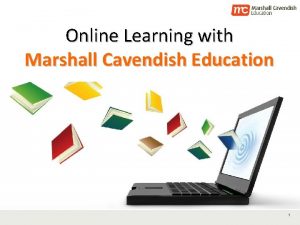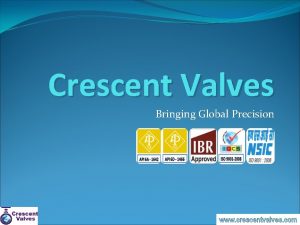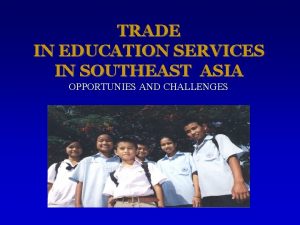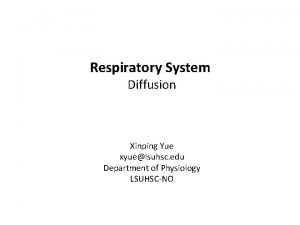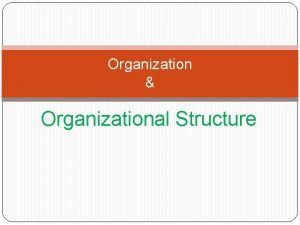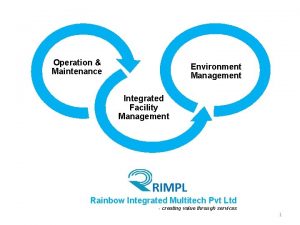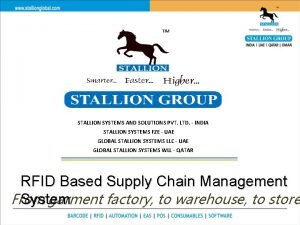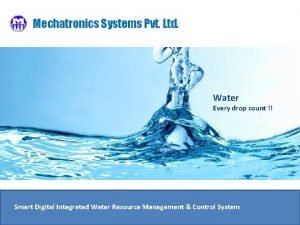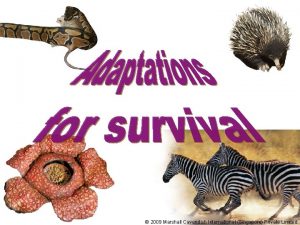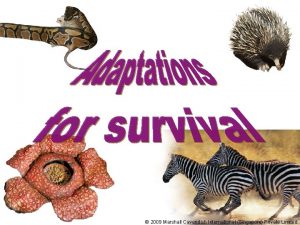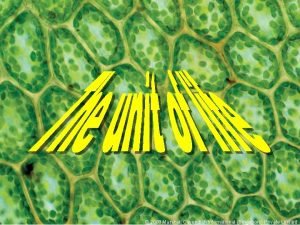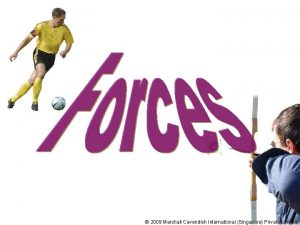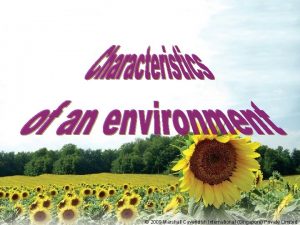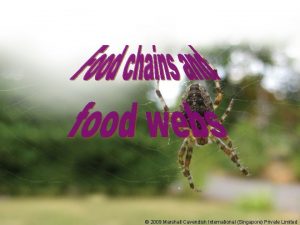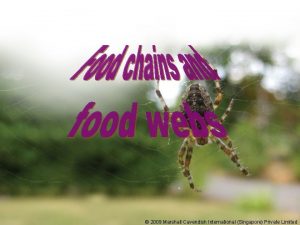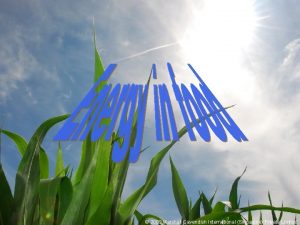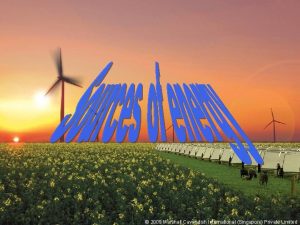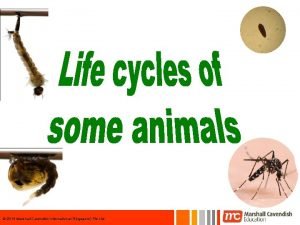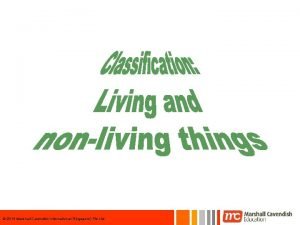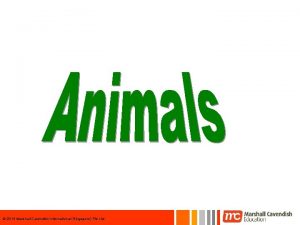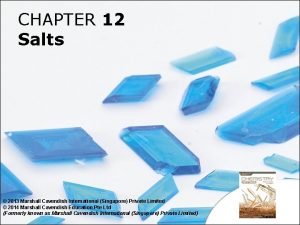2009 Marshall Cavendish International Singapore Private Limited Questions

























- Slides: 25

© 2009 Marshall Cavendish International (Singapore) Private Limited

Questions to think about… What is the source of energy? What are the roles of various organisms? What is a food chain and a food web? © 2009 Marshall Cavendish International (Singapore) Private Limited

Energy from the Sun • All living things depend directly or indirectly on the Sun for energy. • Plants need light from the Sun to make food through photosynthesis. • Some animals get their energy from these plants. • Other animals get their energy from eating these plant-eating animals. • Without the Sun, life cannot exist. © 2009 Marshall Cavendish International (Singapore) Private Limited

Producers • Plants are the only organisms that can use energy from the Sun to make their own food. • Plants are called producers as they are able to produce their own food. © 2009 Marshall Cavendish International (Singapore) Private Limited

Consumers • Animals cannot produce their own food. • They eat plants and other organisms to get the energy they need. • Animals are thus called consumers. © 2009 Marshall Cavendish International (Singapore) Private Limited

Consumers Animals eat plants only eat animals only eat plants and animals herbivores carnivores omnivores © 2009 Marshall Cavendish International (Singapore) Private Limited

Predators and prey • Animals that hunt and feed on other animals are called predators. • Animals that are being hunted and eaten are called prey. • All herbivores are prey. • All carnivores and omnivores are predators, however, they can also be the prey of other carnivores and omnivores. © 2009 Marshall Cavendish International (Singapore) Private Limited

Predators and prey plant herbivore or omnivore carnivore or omnivore © 2009 Marshall Cavendish International (Singapore) Private Limited

Predators and prey • Predators often kill the weak and sick animals. • By killing the prey, predators control the number of prey in the community. • If the number of prey gets too big, there will not be enough food for all the prey to feed on. a hawk eating its prey © 2009 Marshall Cavendish International (Singapore) Private Limited

Predators and prey • The number of predators in a community is in turn dependent on the number of prey. • When the number of prey decreases, predators will have less food. • Thus, their numbers will decrease. © 2009 Marshall Cavendish International (Singapore) Private Limited

Food chains • When a plant is eaten by an animal which is in turn eaten by another animal, we have a food chain. • A food chain shows the food relationship between different organisms. • An example: plant consumer eaten by caterpillar bird © 2009 Marshall Cavendish International (Singapore) Private Limited

Food chains • The caterpillar eats the leaf of the plant, and the bird eats the caterpillar. • In a food chain, energy is transferred from one organism to another. • The energy stored in the plant is passed on to the caterpillar, and then to the bird. plant consumer eaten by caterpillar bird © 2009 Marshall Cavendish International (Singapore) Private Limited

Food webs • An organism usually eats more than one type of food. • An organism can also be eaten by more than one type of organism. • Thus, an organism can belong to more than one food chain. • In a community, food chains are linked together to form a food web. © 2009 Marshall Cavendish International (Singapore) Private Limited

Food webs • An example: aphid ladybird spider plant fruit fly bee caterpillar bird © 2009 Marshall Cavendish International (Singapore) Private Limited

Food webs grass fruit deer rabbit owl Here is are an example There food ofwebs a food web in a infox other forest community. communities too! squirrel tiger © 2009 Marshall Cavendish International (Singapore) Private Limited

Food webs crocodile snake kingfisher fish frog Here insect is an example of a food web in a mangrove monkey swamp community. mangrove plant © 2009 Marshall Cavendish International (Singapore) Private Limited

Keeping a balance plant caterpillar bird In For a example, food or food will happen web, the ifthat populations many of of is • When From With Eventually, more this thechain example, number caterpillars, thewhat number of we birds more can of all decreases, see plants organisms will when the be inthe there eaten the The birds will have less food. Some birds will all caterpillars the producers in and food consumers chain above are kept killed? in. So the number an up, food increase leading chain caterpillars stabilises to orthe less decrease food as will for ainbalance increase the caterpillars. number isbecause reached. of starve toofdeath. So the number ofare birds in athe balance. there predator number areof or fewer caterpillars prey, birds the number towill eatdecrease them. of otherwith organisms time. population decreases. in the food chain will be affected. © 2009 Marshall Cavendish International (Singapore) Private Limited

What happens when we remove a population of organisms from a community? • A With group the of killing farmers of large discovered numbers that of sparrows, sparrows were eating insects that used up a lot to be of their sparrows’ crops. prey grew and • multiplied. So they tried to kill all the sparrows in their • The village. farmers’ efforts failed because eventually, the insects ate a far larger portion of their crops than the sparrows did. Let us Thus, removing a examine afrom a population case study. is not community always a good thing! © 2009 Marshall Cavendish International (Singapore) Private Limited

What happens when we add a population of organisms to a community? • In A hundred 1869, a few years gypsy later, moth the moths eggs were had spread broughtthroughout to North America the north-east for theoffirst thetime United from States. Europe. This was because moths no were natural predatorsasinthey North America. • the These silk had moths in demand are able to produce better silk. all the leaves of the trees, leaving no • The moths ate up for birds to turned build nests. • place But these moths out to be poor silk producers, • Baby and some birdsescaped and otherfrom animals where could theynot were behoused. hidden, and were easily spotted and eaten by predators. What can happen if the opposite occurs? Let us take a look at another example. © 2009 Marshall Cavendish International (Singapore) Private Limited

Decomposers • When plants and animals die, they become food for organisms known as decomposers. • Bacteria and fungi are decomposers. • Decomposers feed on dead matter and animal waste by breaking them down into simple substances such as mineral salts and carbon dioxide. • Most of these simple substances are returned to the soil and air to be used again by plants. © 2009 Marshall Cavendish International (Singapore) Private Limited

Decomposers dead plant dead animal fungi animal waste nutrients for plants bacteria mineral salts in soil decomposers Decomposers break down dead matter and animal waste. © 2009 Marshall Cavendish International (Singapore) Private Limited

Decomposers • Decomposers play an important role in nature by ensuring that the Earth would not be covered by dead matter and animal waste. • At the same time, they provide the soil with nutrients for plants to grow. mould breaking down the nectarines © 2009 Marshall Cavendish International (Singapore) Private Limited

Animals that feed on dead organisms • Some animals are not decomposers. • Instead, they help decomposers to break down dead organisms to simple substances more quickly. • They do this by biting or breaking up dead organisms into smaller pieces. © 2009 Marshall Cavendish International (Singapore) Private Limited

Animals that feed on dead organisms • Animals that feed on dead plant matter include snails, earthworms, millipedes, termites and woodlice. • Animals that feed on dead animals include vultures, blowflies and flesh flies. • Female flies usually lay their eggs near or in the flesh of dead organisms. • When the eggs hatch, the maggots feed on the decaying flesh. • Decomposers like bacteria then complete the breakdown of the dead matter. © 2009 Marshall Cavendish International (Singapore) Private Limited

© 2009 Marshall Cavendish International (Singapore) Private Limited
 2009 marshall cavendish international
2009 marshall cavendish international 2009 marshall cavendish international
2009 marshall cavendish international Mc online
Mc online Marshall cavendish
Marshall cavendish Crescent valves
Crescent valves Bellerbys educational services limited singapore branch
Bellerbys educational services limited singapore branch Perfusion vs diffusion limited
Perfusion vs diffusion limited Korean school singapore
Korean school singapore Rick griffith
Rick griffith Crossroads international church singapore
Crossroads international church singapore Stiriti ayur therapies private limited
Stiriti ayur therapies private limited Skyhms
Skyhms Pragati automation private limited
Pragati automation private limited Organizational structure of private hospital
Organizational structure of private hospital Rainbow integrated multitech private limited
Rainbow integrated multitech private limited Join hands marine services private limited
Join hands marine services private limited Genesis gas solutions private limited
Genesis gas solutions private limited Gaveshana geosciences private limited
Gaveshana geosciences private limited Exhaust technology pvt ltd
Exhaust technology pvt ltd Alexis global
Alexis global Stallion systems
Stallion systems Rajshi technologies india private limited
Rajshi technologies india private limited Rtdas system
Rtdas system Sanvo resorts private limited
Sanvo resorts private limited Disa decorations private limited
Disa decorations private limited Birla medisoft private limited
Birla medisoft private limited


